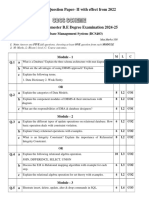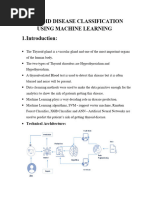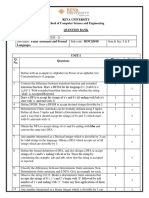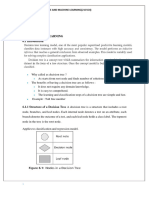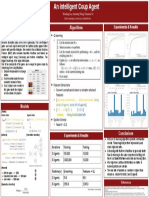Question Bank - Module 2 - Module-3 Module 4 -Module 5
Uploaded by
nothingspecialtommyQuestion Bank - Module 2 - Module-3 Module 4 -Module 5
Uploaded by
nothingspecialtommySRI KRISHNA INSTITUTE OF TECHNOLOGY
(Accredited by NAAC, Approved by A.I.C.T.E. New Delhi, Recognised by Govt. of Karnataka & Affiliated to V.T U., Belagavi)
#29, Chimney Hills, Hesaraghatta Main Road, Chikkabanavara Post, Bengaluru- 560090
Dept. of Information Science & Engineering
Deep Learning (21CS743)
Question Bank
Module 2 - Regularization
QUESTIONS COS BT
1. What is regularization? List and explain the different strategies to
CO2 L2
create regularized model.
2. What is L2 Normalization? Explain its weight decay strategy and CO2 L2
also show its effects on the optimal value of w.
3. What is L1 regularization? Explain the difference between L1 and CO2 L2
L2 normal forms.
4. What is Hessian Matrix? Explain. CO2 L2
5. Explain parameter norm penalties. CO2 L2
6. Explain Dataset augmentation. CO2 L2
7. Explain the following: CO2 L2
a. Multi Task Learning
b. Semi-Supervised Learning
c. Noise Robustness
d. Early Stopping
e. Parameter Typing and Parameter Sharing
f. Sparse Representation
g. Bagging
h. Adversarial Training
8. What is dropout? What is its significance in regularization? Explain CO2 L2
with an example.
Ragini Krishna, Dept. ISE, SKIT. Page 1
SRI KRISHNA INSTITUTE OF TECHNOLOGY
(Accredited by NAAC, Approved by A.I.C.T.E. New Delhi, Recognised by Govt. of Karnataka & Affiliated to V.T U., Belagavi)
#29, Chimney Hills, Hesaraghatta Main Road, Chikkabanavara Post, Bengaluru- 560090
Dept. of Information Science & Engineering
Deep Learning (21CS743)
Question Bank
Module 3 - Optimization
QUESTIONS COS BT
1. How learning differs from pure Optimization. CO3 L2
2. What is Surrogate Loss Functions and Early Stopping? CO3 L2
3. Explain Batch and Mini Batch Algorithms. What are the factors on CO3 L2
which Mini Batch size is decided?
4. List and Explain the Challenges involved in Neural Network Optim- CO3 L2
ization? Explain with examples.
5. Write the algorithm for Stochastic Gradient Descent. CO3 L2
6. What is Momentum? Write and Explain SGD with Momentum Al- CO3 L2
gorithm and why is it needed.
7. Write and explain Nesterov Momentum (NAG) algorithm. CO3 L2
8. Explain the following adaptive optimization learning Algorithms. CO3 L2
a. AdaGrad
b. RMSProp
c. Adam
9. Explain the following Approximate Second Order Methods: CO3 L2
a. Newton’s Method
b. Conjugate Gradients
c. Broyden–Fletcher–Goldfarb–Shanno (BFGS) algorithm
10. Explain the following Optimization Strategies and Meta-Algorithms: CO3 L2
a. Batch Normalization
b. Coordinate Descent
c. Polyak Averaging
d. Supervised Pretraining
Ragini Krishna, Dept. ISE, SKIT. Page 2
SRI KRISHNA INSTITUTE OF TECHNOLOGY
(Accredited by NAAC, Approved by A.I.C.T.E. New Delhi, Recognised by Govt. of Karnataka & Affiliated to V.T U., Belagavi)
#29, Chimney Hills, Hesaraghatta Main Road, Chikkabanavara Post, Bengaluru- 560090
Dept. of Information Science & Engineering
Deep Learning (21CS743)
Question Bank
Module 4 - CNN
QUESTIONS COS BT
1. What is Convolution Neural Network? Explain with a diagram. CO2 L2
2. Explain Convolution Operation. With a neat diagram explain the 2- CO2 L2
D convolution without kernel-flipping
3. With a neat diagram explain how sparse connectivity of data is CO2 L2
handled in CNN
4. With a neat diagram explain the components of a typical convolu- CO2 L2
tional neural network layer.
5. Explain the significance of pooling in CNN. Explain the working of CO2 L2
pooling with a neat diagram.
6. CO2 L2
rd CO2 L2
3 Internals
7. What are variants of Convolution Function? Explain Strides with ex- CO2 L2
amples. Also Show the effect of zero padding on network size.
8. What is Unshared Convolution? Explain the same mathematically CO2 L2
and with a neat diagram.
9. What is tiled Convolution? Give a Comparison of locally connected CO2 L2
layers, titled convolution and standard convolution.
10. What is transpose Convolution? CO2 L2
11. What are the different data formats supported by Convolution neural CO2 L2
network? Give examples.
12. What is Gabor function? Explain it with a variety of parameter with CO2 L2
a diagram.
Module 5 – RNN and other Applications
QUESTIONS COS BT
1. Define RNN. Explain unfolding of computational graphs. CO2 L2
2. What is RNN? Explain the important design patterns of Recurrent CO2 L2
Neural Networks.
Ragini Krishna, Dept. ISE, SKIT. Page 3
SRI KRISHNA INSTITUTE OF TECHNOLOGY
(Accredited by NAAC, Approved by A.I.C.T.E. New Delhi, Recognised by Govt. of Karnataka & Affiliated to V.T U., Belagavi)
#29, Chimney Hills, Hesaraghatta Main Road, Chikkabanavara Post, Bengaluru- 560090
Dept. of Information Science & Engineering
3. Explain the concept of teacher forcing in Recurrent Neural Network CO2 L2
with a neat diagram.
4. What is Back Propagation Through Time (BPTT) algorithm? Ex- CO2 L2
plain how BPTT behaves.
5. State the various ways of representing RNN as various directed CO2 L2
graphical model.
6. Explain Modeling sequences conditioned in context with RNN CO2 L2
7. Explain the computation of bi directional Recurrent Neural Network. CO2 L2
8. Explain how an RNN can map an input sequence to an output se- CO2 L2
quence of the same length.
9. Explain how an RNN can map a fixed-size vector to a sequence. CO2 L2
10. Explain encoder-decoder sequence-sequence RNN architecture. CO2 L2
11. What are the various ways in which a recurrent neural network can CO2 L2
be made deep in many ways? Explain each with a neat diagram.
12. What are the various parameters that needs to be considered for CO2 L2
Large Scale Deep Learning? Explain them.
13. What are steps involved in Computer Vision? Explain them. CO2 L2
14. What is Natural Language Processing? List and explain the steps in- CO2 L2
volved in NLP.
Ragini Krishna, Dept. ISE, SKIT. Page 4
You might also like
- PowerPoint Presentation On Artificial Intelligence100% (3)PowerPoint Presentation On Artificial Intelligence14 pages
- Transportation in Chhattisgarh and KeralaNo ratings yetTransportation in Chhattisgarh and Kerala10 pages
- @vtucode - in - CN QUESTION BANK 2021 SCHEMENo ratings yet@vtucode - in - CN QUESTION BANK 2021 SCHEME7 pages
- R22B Tech CSE (AIML) IandIIYearSyllabus PDFNo ratings yetR22B Tech CSE (AIML) IandIIYearSyllabus PDF65 pages
- Sigmoid Function: Soft Computing Assignment100% (1)Sigmoid Function: Soft Computing Assignment12 pages
- East West Institute of Technology: Sadp NotesNo ratings yetEast West Institute of Technology: Sadp Notes30 pages
- Assignment - Week 6 (Neural Networks) Type of Question: MCQ/MSQNo ratings yetAssignment - Week 6 (Neural Networks) Type of Question: MCQ/MSQ4 pages
- CCS355 Neural Networks and Deep LearningNo ratings yetCCS355 Neural Networks and Deep Learning142 pages
- Thyroid Disease Classification Using Machine Learning ProjectNo ratings yetThyroid Disease Classification Using Machine Learning Project34 pages
- 5 Unit 3 - Forward Chaining and Backward Chaining in AINo ratings yet5 Unit 3 - Forward Chaining and Backward Chaining in AI18 pages
- Artificial Intelligence - Knowledge Representation and Reasoning - Unit 8 - Week 5100% (1)Artificial Intelligence - Knowledge Representation and Reasoning - Unit 8 - Week 55 pages
- Model Question Paper II - 21cs642 - 6 Sem (2021 Scheme)No ratings yetModel Question Paper II - 21cs642 - 6 Sem (2021 Scheme)2 pages
- TOC Question Bank - Unit - 1 - 2 - 3 - 4 - 2022No ratings yetTOC Question Bank - Unit - 1 - 2 - 3 - 4 - 20227 pages
- 18CS42 Model Question Paper - 1 With Effect From 2019-20 (CBCS Scheme)No ratings yet18CS42 Model Question Paper - 1 With Effect From 2019-20 (CBCS Scheme)3 pages
- Gujarat Technological University: Computer Engineering Machine Learning SUBJECT CODE: 3710216No ratings yetGujarat Technological University: Computer Engineering Machine Learning SUBJECT CODE: 37102162 pages
- Introduction To Machine Learning - Unit 3 - Week 1 - Non - GradedNo ratings yetIntroduction To Machine Learning - Unit 3 - Week 1 - Non - Graded3 pages
- CH 10: Expert Systems:: Representing Using Domain Knowledge Expert System Shells Explanation, Knowledge AcquisitionNo ratings yetCH 10: Expert Systems:: Representing Using Domain Knowledge Expert System Shells Explanation, Knowledge Acquisition22 pages
- Design and Analysis of Algorithms Laboratory (15Csl47)100% (1)Design and Analysis of Algorithms Laboratory (15Csl47)12 pages
- BCS358D Data Visualization With Python SyallabusNo ratings yetBCS358D Data Visualization With Python Syallabus4 pages
- CS 522 Selected Topics in CS: Lecture 07 - Artificial Neural NetworkNo ratings yetCS 522 Selected Topics in CS: Lecture 07 - Artificial Neural Network52 pages
- Exploring Deep Learning and Neural Networks in Data Science (1)No ratings yetExploring Deep Learning and Neural Networks in Data Science (1)11 pages
- Asset-V1 MITx+6.86x+3T2020+typeasset+blockslides Lecture12 Compressed PDFNo ratings yetAsset-V1 MITx+6.86x+3T2020+typeasset+blockslides Lecture12 Compressed PDF13 pages
- Ugrd Ai6100 Ai Prompt Engineering Midterm ExamNo ratings yetUgrd Ai6100 Ai Prompt Engineering Midterm Exam15 pages
- Time Series Classification From Scratch With Deep Neural NetworksNo ratings yetTime Series Classification From Scratch With Deep Neural Networks9 pages
- Deep Neural Network For RFID-Based Activity RecognitionNo ratings yetDeep Neural Network For RFID-Based Activity Recognition3 pages
- [Ebooks PDF] download Automated Machine Learning in Action 1st Edition Qingquan Song full chapters100% (3)[Ebooks PDF] download Automated Machine Learning in Action 1st Edition Qingquan Song full chapters40 pages
- Back Propagation Network: Soft ComputingNo ratings yetBack Propagation Network: Soft Computing33 pages
- Convolutional, Long Short-Term Memory, Fully Connected Deep Neural NetworksNo ratings yetConvolutional, Long Short-Term Memory, Fully Connected Deep Neural Networks5 pages
- Deep Learning in The Era of Big Data: Foundations, Advances, Applications, Challenges, and Future DirectionsNo ratings yetDeep Learning in The Era of Big Data: Foundations, Advances, Applications, Challenges, and Future Directions4 pages
- Convolution Neural Networks Vs Fully Connected Neural NetworksNo ratings yetConvolution Neural Networks Vs Fully Connected Neural Networks6 pages
- IMP - Fundamentals of Deep Learning - Introduction To Recurrent Neural NetworksNo ratings yetIMP - Fundamentals of Deep Learning - Introduction To Recurrent Neural Networks33 pages
- Testing of Different Machine Learning Algorithm For DetectingNo ratings yetTesting of Different Machine Learning Algorithm For Detecting18 pages
- Artificial Neural Network-Adaline & MadalineNo ratings yetArtificial Neural Network-Adaline & Madaline18 pages
- PowerPoint Presentation On Artificial IntelligencePowerPoint Presentation On Artificial Intelligence
- Assignment - Week 6 (Neural Networks) Type of Question: MCQ/MSQAssignment - Week 6 (Neural Networks) Type of Question: MCQ/MSQ
- Thyroid Disease Classification Using Machine Learning ProjectThyroid Disease Classification Using Machine Learning Project
- 5 Unit 3 - Forward Chaining and Backward Chaining in AI5 Unit 3 - Forward Chaining and Backward Chaining in AI
- Artificial Intelligence - Knowledge Representation and Reasoning - Unit 8 - Week 5Artificial Intelligence - Knowledge Representation and Reasoning - Unit 8 - Week 5
- Model Question Paper II - 21cs642 - 6 Sem (2021 Scheme)Model Question Paper II - 21cs642 - 6 Sem (2021 Scheme)
- 18CS42 Model Question Paper - 1 With Effect From 2019-20 (CBCS Scheme)18CS42 Model Question Paper - 1 With Effect From 2019-20 (CBCS Scheme)
- Gujarat Technological University: Computer Engineering Machine Learning SUBJECT CODE: 3710216Gujarat Technological University: Computer Engineering Machine Learning SUBJECT CODE: 3710216
- Introduction To Machine Learning - Unit 3 - Week 1 - Non - GradedIntroduction To Machine Learning - Unit 3 - Week 1 - Non - Graded
- CH 10: Expert Systems:: Representing Using Domain Knowledge Expert System Shells Explanation, Knowledge AcquisitionCH 10: Expert Systems:: Representing Using Domain Knowledge Expert System Shells Explanation, Knowledge Acquisition
- Design and Analysis of Algorithms Laboratory (15Csl47)Design and Analysis of Algorithms Laboratory (15Csl47)
- CS 522 Selected Topics in CS: Lecture 07 - Artificial Neural NetworkCS 522 Selected Topics in CS: Lecture 07 - Artificial Neural Network
- Exploring Deep Learning and Neural Networks in Data Science (1)Exploring Deep Learning and Neural Networks in Data Science (1)
- Asset-V1 MITx+6.86x+3T2020+typeasset+blockslides Lecture12 Compressed PDFAsset-V1 MITx+6.86x+3T2020+typeasset+blockslides Lecture12 Compressed PDF
- Time Series Classification From Scratch With Deep Neural NetworksTime Series Classification From Scratch With Deep Neural Networks
- Deep Neural Network For RFID-Based Activity RecognitionDeep Neural Network For RFID-Based Activity Recognition
- [Ebooks PDF] download Automated Machine Learning in Action 1st Edition Qingquan Song full chapters[Ebooks PDF] download Automated Machine Learning in Action 1st Edition Qingquan Song full chapters
- Convolutional, Long Short-Term Memory, Fully Connected Deep Neural NetworksConvolutional, Long Short-Term Memory, Fully Connected Deep Neural Networks
- Deep Learning in The Era of Big Data: Foundations, Advances, Applications, Challenges, and Future DirectionsDeep Learning in The Era of Big Data: Foundations, Advances, Applications, Challenges, and Future Directions
- Convolution Neural Networks Vs Fully Connected Neural NetworksConvolution Neural Networks Vs Fully Connected Neural Networks
- IMP - Fundamentals of Deep Learning - Introduction To Recurrent Neural NetworksIMP - Fundamentals of Deep Learning - Introduction To Recurrent Neural Networks
- Testing of Different Machine Learning Algorithm For DetectingTesting of Different Machine Learning Algorithm For Detecting



